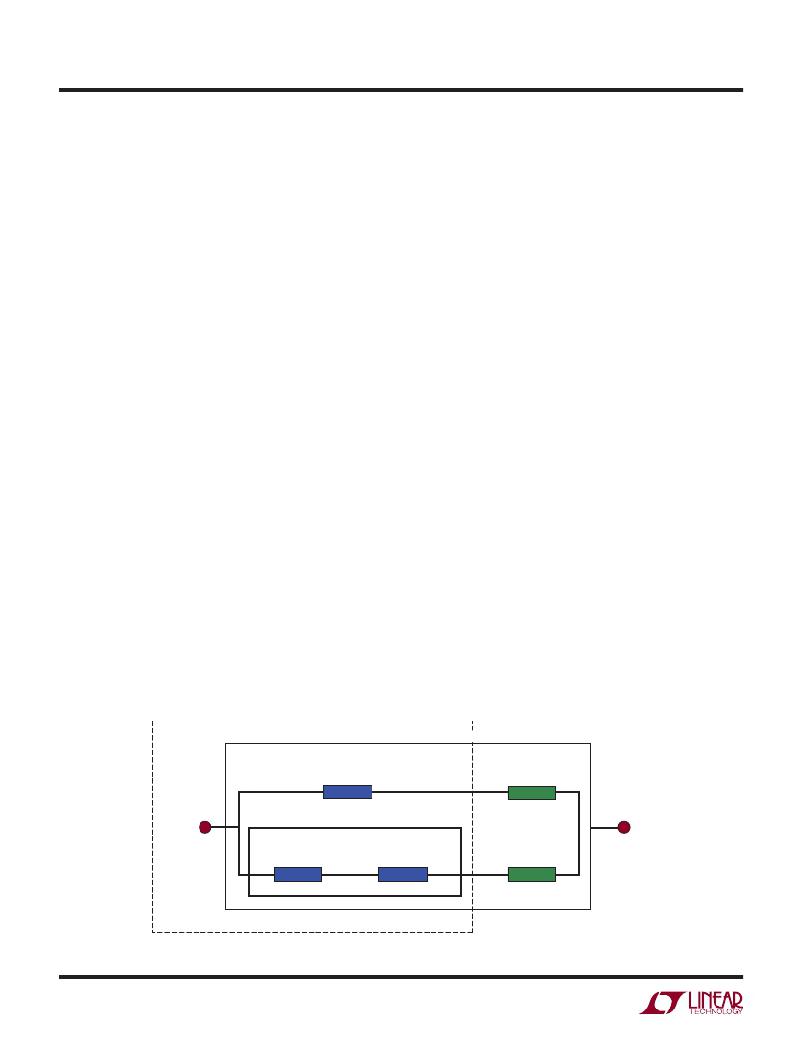- 您现在的位置:买卖IC网 > Sheet目录868 > LTM4618IV#PBF (Linear Technology)IC DC-DC UMODULE BUCK 6A 84-LGA
�� �
�
 �
�LTM4618�
�APPLICATIONS� INFORMATION�
�board,� and� is� really� the� sum� of� the� θ� JCbottom� and� the�
�thermal� resistance� of� the� bottom� of� the� part� through�
�the� solder� joints� and� through� a� portion� of� the� board.�
�The� board� temperature� is� measured� at� speci?ed� dis-�
�tance� from� the� package,� using� a� two� sided,� two� layer�
�board.� This� board� is� described� in� JESD� 51-9.�
�A� graphical� representation� of� the� forementioned� thermal�
�resistances� is� given� in� Figure� 6;� blue� resistances� are�
�contained� within� the� μModule� regulator,� whereas� green�
�resistances� are� external� to� the� μModule� regulator.�
�As� a� practical� matter,� it� should� be� clear� to� the� reader� that�
�no� individual� or� sub-group� of� the� four� thermal� resistance�
�parameters� de?ned� by� JESD� 51-12� or� provided� in� the�
�Pin� Con?guration� section� replicates� or� conveys� normal�
�operating� conditions� of� a� μModule� regulator.� For� example,�
�in� actual� board-mounted� applications,� never� does� 100%�
�of� the� device’s� total� power� loss� (heat)� thermally� conduct�
�exclusively� through� the� top� or� exclusively� through� bot-�
�tom� of� the� μModule� regulator—as� the� standard� de?nes�
�for� θ� JCtop� and� θ� JCbottom� ,� respectively.� In� practice,� power�
�loss� is� thermally� dissipated� in� both� directions� away� from�
�the� package—granted,� in� the� absence� of� a� heat� sink� and�
�air?ow,� a� majority� of� the� heat� ?ow� is� into� the� board.�
�Within� a� SIP� (System-In-Package)� module,� be� aware� there�
�are� multiple� power� devices� and� components� dissipating�
�power,� with� a� consequence� that� the� thermal� resistances�
�relative� to� different� junctions� of� components� or� die� are� not�
�exactly� linear� with� respect� to� total� package� power� loss.� To�
�reconcile� this� complication� without� sacri?cing� modeling�
�simplicity—but� also,� not� ignoring� practical� realities—an�
�approach� has� been� taken� using� FEA� software� modeling�
�along� with� laboratory� testing� in� a� controlled-environment�
�chamber� to� reasonably� de?ne� and� correlate� the� thermal�
�resistance� values� supplied� in� this� data� sheet:� (1)� Initially,�
�FEA� software� is� used� to� accurately� build� the� mechanical�
�geometry� of� the� μModule� regulator� and� the� speci?ed� PCB�
�with� all� of� the� correct� material� coef?cients� along� with�
�accurate� power� loss� source� de?nitions;� (2)� this� model�
�simulates� a� software-de?ned� JEDEC� environment� consis-�
�tent� with� JSED51-9� to� predict� power� loss� heat� ?ow� and�
�temperature� readings� at� different� interfaces� that� enable�
�the� calculation� of� the� JEDEC-de?ned� thermal� resistance�
�values;� (3)� the� model� and� FEA� software� is� used� to� evalu-�
�ate� the� μModule� regulator� with� heat� sinks� and� air?ow;� (4)�
�having� solved� for� and� analyzed� these� thermal� resistance�
�values� and� simulated� various� operating� conditions� in� the�
�software� model,� a� thorough� laboratory� evaluation� replicates�
�the� simulated� conditions� with� thermocouples� within� a�
�controlled-environment� chamber� while� operating� the� device�
�at� the� same� power� loss� as� that� which� was� simulated.� An�
�outcome� of� this� process� and� due-diligence� yields� a� set�
�of� derating� curves� provided� in� other� sections� of� this� data�
�sheet.� After� these� laboratory� tests� have� been� performed�
�and� correlated� to� the� μModule� package� model,� then� the�
�θ� JB� and� θ� BA� are� summed� together� to� correlate� quite� well�
�with� the� μModule� package� model� with� no� air� ?ow� or� heat�
�sinking� in� a� properly� de?ne� chamber.� This� θ� JB� +� θ� BA� value�
�is� shown� in� the� Pin� Con?guration� section� and� should� ac-�
�curately� equal� the� θ� JA� value� because� approximately� 100%�
�of� power� loss� ?ows� from� the� junction� through� the� board�
�into� ambient� with� no� air?ow� or� top� mounted� heat� sink.�
�JUNCTION-TO-AMBIENT RESISTANCE (JESD 51-9 DEFINED BOARD)�
�JUNCTION-TO-CASE� (TOP)�
�RESISTANCE�
�CASE� (TOP)-TO-AMBIENT�
�RESISTANCE�
�JUNCTION�
�JUNCTION-TO-BOARD� RESISTANCE�
�At�
�JUNCTION-TO-CASE�
�(BOTTOM)� RESISTANCE�
�CASE� (BOTTOM)-TO-BOARD�
�RESISTANCE�
�BOARD-TO-AMBIENT�
�RESISTANCE�
�4618� F06�
�μMODULE� DEVICE�
�Figure� 6.� Graphical� Representation� of� JESD51-12� Thermal� Coef?cients�
�4618fa�
�14�
�发布紧急采购,3分钟左右您将得到回复。
相关PDF资料
LTM4619IV#PBF
IC SWIT REG BUCK 4A ADJ 144LGA
LTM4627MPY#PBF
IC DC/DC UMODULE 15A 133-BGA
LTM4628EV#PBF
IC DC/DC UMODULE 16A 144-LGA
LTM8008HV#PBF
IC DC/DC UMODULE 16-LGA
LTM8020IV#PBF
IC DC/DC UMODULE 200MA 21-LGA
LTM8023MPV#PBF
IC BUCK SYNC ADJ 2A 50LGA
LTM8025MPV#PBF
IC CONVERTER BUCK 3A ADJ 70LGA
LTM8026MPV#PBF
IC UMODULE 36VIN 5A CVCC 81LGA
相关代理商/技术参数
LTM4618IVPBF
制造商:LINER 制造商全称:Linear Technology 功能描述:6A DC/DC μModule Regulator with Tracking and Frequency Synchronization
LTM4618V
制造商:LINER 制造商全称:Linear Technology 功能描述:6A DC/DC μModule Regulator with Tracking and Frequency Synchronization
LTM4619
制造商:LINER 制造商全称:Linear Technology 功能描述:Dual, 26VIN, 4A DC/DC μModule Regulator
LTM4619EV
制造商:LINER 制造商全称:Linear Technology 功能描述:Dual, 26VIN, 4A DC/DC μModule Regulator
LTM4619EV#PBF
功能描述:IC SWIT REG BUCK 4A ADJ 144LGA RoHS:是 类别:电源 - 板载 >> DC DC Converters 系列:µModule® 设计资源:VI-200, VI-J00 Design Guide, Appl Manual 标准包装:1 系列:* 类型:隔离 输出数:1 电压 - 输入(最小):66V 电压 - 输入(最大):160V Voltage - Output 1:12V Voltage - Output 2:- Voltage - Output 3:- 电流 - 输出(最大):* 电源(瓦) - 制造商系列:50W 电压 - 隔离:* 特点:* 安装类型:通孔 封装/外壳:9-FinMod 尺寸/尺寸:4.60" L x 1.86" W x 0.79" H(116.8mm x 47.2mm x 20.1mm) 包装:散装 工作温度:-25°C ~ 85°C 效率:* 电源(瓦特)- 最大:*
LTM4619EVPBF
制造商:Linear Technology 功能描述:Conv DC-DC Dual-Out Step Down
LTM4619IV
制造商:LINER 制造商全称:Linear Technology 功能描述:Dual, 26VIN, 4A DC/DC μModule Regulator
LTM4619IV#PBF
功能描述:IC SWIT REG BUCK 4A ADJ 144LGA RoHS:是 类别:电源 - 板载 >> DC DC Converters 系列:µModule® 设计资源:VI-200, VI-J00 Design Guide, Appl Manual 标准包装:1 系列:* 类型:隔离 输出数:1 电压 - 输入(最小):66V 电压 - 输入(最大):160V Voltage - Output 1:12V Voltage - Output 2:- Voltage - Output 3:- 电流 - 输出(最大):* 电源(瓦) - 制造商系列:50W 电压 - 隔离:* 特点:* 安装类型:通孔 封装/外壳:9-FinMod 尺寸/尺寸:4.60" L x 1.86" W x 0.79" H(116.8mm x 47.2mm x 20.1mm) 包装:散装 工作温度:-25°C ~ 85°C 效率:* 电源(瓦特)- 最大:*